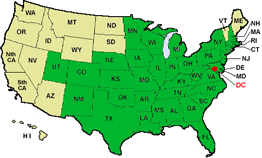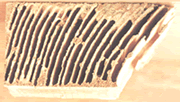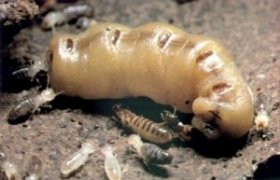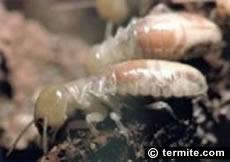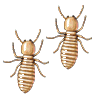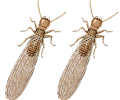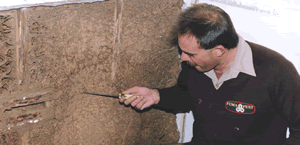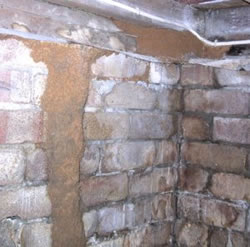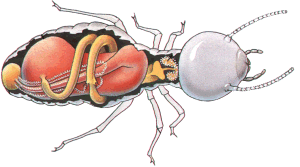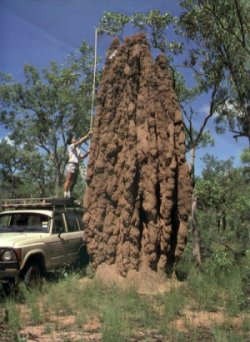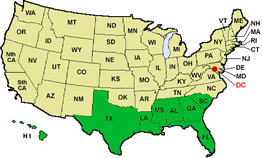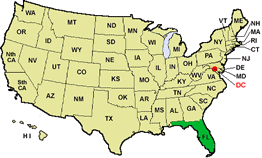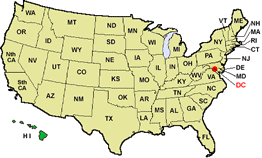| About Termites |
| Termite Control |
| Exterra |
| Sentricon |
| Pest Control |
| Spider Identification |
| Consumer Advice |
| Links / Resources |
| Home |
| Destructive Termites in Florida |
| Identification of the main destructive species |
| It is critical to identify the species of destructive termites to formulate
an appropriate control program. The main species of destructive
termites in Florida are: CONTENTS: learn about destructive species of termites - tips on identification of the timber damage - find out when they swarm in your local area and how to identify the swarmers, workers and soldiers - learn about their fascinating biology, life-cycle and behavioural aspects - and receive professional tips on how best to protect your home from the world's best timber recycler .... subterranean termites. |
Areas of high risk in Florida include Boca Raton - Cape Coral - Clearwater - Coral Springs - Davie - Deerfield Beach - Deltona - Fort Lauderdale - Gainesville - Hialeah - Hollywood - Jacksonville - Lakeland - Largo - Melbourne - Miami - Miami Beach - Miami Gardens - Miramar - Orlando - Palm Bay - Pembroke Pines - Plantation - Pompano Beach - Port St Lucie - St Petersburg - Sunrise - Tallahassee - Tampa - West Palm Beach . |
As a result, infested timbers are often left as a thin external shell, with layered "honey-comb" hollow sections (as illustrated) packed with moist soil. Eastern subterranean termites thrive in a moist dark environment. Moisture and humidity control are essential for their survival. |
| The Eastern subterranean termite is a serious economic timber pest causing millions of dollars of damage throughout Florida. It is estimated that more than 1 in 5 homes in the urban areas of most Florida cities have been or will be attacked at sometime by these voracious little insects. |
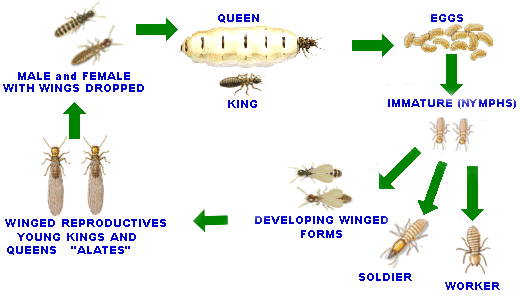
|
|
|
As noted above, termites constantly groom and feed each other. A valuable technique for the termite controller is to instal and monitor a termite baiting system next to any live activity found in and around the premises where termite foraging is most likely to occur. Subsequent inspections (preferably monthly) may reveal dead or sick worker termites, they change colour to a mottle look, and spread of the termite bait to other termites leading to elimination of the colony. The termite baits are designed to be non-repellant to the termites and has a unique delayed effect. Time enough to be passed onto the other termites in the colony including the queen, with a sufficient dosage leading to the elimination of the entire colony. This process is explained in detail in the Termite Control section of this website. |
Eastern subterranean termites have acute survival instincts. If they
are shaken up or disturbed, the termites often will abandon the associated
area and move on to secretly
cause damage in other areas in the building. If you find eastern
subterranean termites in or around your property, it is essential that you
do NOT disturb them and promptly arrange for a professional inspection and
application of a termite bait to the live termites, if present in abundance.
|
| Formosan subterranean termites |
Economic Significance: Formosan termites
are the most aggressive and destructive timber pests in the United States.
It is an imported species, native to China.
It can develop huge nests containing millions of termites aggressively and relentlessly seeking and devouring structural timbers, utility poles and other timber structures, including ships and barges. Infestation can occur to living trees, such as oak, cypress, pine and maple. They often cause power failures by chewing through electrical cabling. A termite to be feared - it is known to cause major structural timber damage to homes and buildings within a few months.
Formosan termites are a serious timber pest in Hawaii and coastal regions of Texas, Louisiana, Alabama, Florida, Tennessee, Georgia, South Carolina and southern California, as well as, inland towns and cities. The Formosan termite is rarely found North of 35° N latitude. They have been reported from the following states: Alabama, California, Florida, Georgia, Hawaii, Louisiana, Mississippi, North Carolina, South Carolina, Tennessee, and Texas. Their distribution will probably continue to be restricted to southern areas because their eggs will not hatch below about 20° C (68° F). Identification of Swarmers and Soldiers: Formosan termites swarm in huge numbers in late spring or summer; usually following a warm rainy day. They prefer to swarm in times of high humidity in the evening hours from dusk to midnight. The swarmers are attracted to lights and are about 1/25'', including wings. Their body color is pale yellowish brown. A fontanelle (frontal gland pore) is present. The swarmers have four wings of equal size with dark hard veins in the front portion of the front wing. The wings are a translucent, slightly milky color and covered with tiny hairs. The armoured head of the soldier is rounded tapering toward the front. A fontanelle (frontal gland pore) is present on the soldier's forehead. They have large mandibles relative to their body, which is flat and narrower than the head. When disturbed the Formosan soldier termite may emit a white sticky latex substance from it's fontanelle - a defensive measure to ensnare their enemies, primarily ants. Identification of Timber Damage: Formosan termites eat mainly the springwood of susceptible timbers, most often leaving the summer wood sections. Timbers infested by Formosan termites usually have layered sections packed with moist soil in high activity areas. Biology and Habits: Formosan termites are subterranean termites that typically live in the ground and a large mature nest will periodically emit swarmers in large numbers over a wide area to find a mate from another colony nest to start up a new colony. A suitable location for nesting should provide a constant moisture source and a readily available timber food source close by. Several years are required before the termite colony reaches the typically mature size, which may contain millions of termites foraging for timber food sources within a 400 feet radius, actively feeding on trees and free-standing poles as well as buildings and other timber structures. The colony nests of Formosan termites are usually located in the ground below the frost line, but above the water table. They typically construct mud galleries or "shelter tubes" across hard objects in order to gain access to timber food sources. Formosan termites constantly search for new food sources. They are known to enter buildings through cracks in concrete flooring or to travel under parquetry or tile flooring through gaps of less than 1/16" wide. The space between the foundation and the first mortar joint is often enough space for termites to enter a home. Formosan termites can establish secondary colonies in very moist wood of upper stories of buildings (even several stories above ground) and do not need soil contact if there is a nearly constant moisture source. Where moisture regularly collects inside the wall or other cavities of a building, say from faulty plumbing or broken roof tiles, the Formosan termite can develop a subsidiary colony nest, which may not require contact with the ground to ensure its survival. This is particularly prevalent in areas of high humidity where wood moisture is above average. Due to its size and aggressive foraging behaviour a colony of Formosan termites does more damage than single colonies of other U.S. subterranean species, and can cause significant structural damage to a home within 6 months. |
| Powderpost drywood termites |
Cryptotermes drywood termites are sometimes discovered in other states after being transported in furniture or other timbers. Cryptotermes drywood termites infest the structural timbers of buildings, furniture and other dry timbers having less than 12% timber moisture content. This termite species require no ground contact and obtain their required moisture intake from the timber they infest. Cryptotermes drywood termites are sometimes called "powderpost" termites or "furniture" termites due to their small faecal droppings and the fact that they commonly attack timber furniture. The average moisture content of seasoned timbers in service in the United States is 8-12%, except along the coastal plains where the moisture level can exceed 12%. Identification of Swarmers and Soldiers: Swarmers are about 7/16-1/2" long including the wings, with the head width being 1/32-1/16". The head and body are pale yellowish brown to pale reddish brown and the wings are hardened and pigmented. The veins are pale yellowish brown in the outer half of the wing. The front wings have 3 dark, heavily sclerotized veins in the front half of the wing. The median vein is un-sclerotized and runs midway between sclerotized veins above and unsclerotized area below. The area ends near the wing tip even if branched along its length and is not hairy. The tibia have spines lacking along their length, apex has 3 spines. The head of the Cryptotermes drywood termite soldier is short and thick in front, the front surrounded by a flange and the front part nearly black. Mandibles re-curved under front of head, with an unequal number of teeth on each member of pair. The tibia lacks spines along length. Identification of Timber Damage: The most obvious sign of infestation is the piles of tiny faecal pellets ejected through temporary holes in the infested timber. The faecal pellets are hard, elongated and oval with rounded ends, and have six concave sides. Cryptotermes drywood termites eat across the wood grain and make chambers or galleries connected by tunnels. Other signs of infestation include the presence of swarmers or their shed wings, piles of faecal pellets, termite plugs which seal all openings in infested wood, and surface blisters caused by older enlarged galleries very close to the wood surface. Occasionally they may build shelter tubes constructed of pellets cemented together to bridge over to an adjacent piece of wood. Biology and Habits: Cryptotermes drywood termites do not live in the ground. They obtain all the moisture required from the timber they infest. They do not require contact with the ground and do not build mud shelter tubes. Their colonies are located in the wood they eat and are small in size, containing perhaps a few thousand termites. It is commonplace to have multiple colonies in the same building. Cryptotermes drywood termite infestations tend to be localised in buildings, in doors, window trims, fascias, even picture frames. They eat the springwood as well as the summerwood. The cavities they excavate in timbers are clean and smooth, and do not contain any mud packing, in contrast with subterranean termites. |
| Florida dampwood termites |
Neotermes are common in the subtropical woodlands, mangrove forests, and urban settings of the coastal peninsula of Florida and the Florida Keys. Neotermes castaneus has the greatest distribution in Florida with its northern limits extending to Merritt Island on the eastern coast and Pinellas County on the Gulf coast. Inland infestations of Neotermes castaneus have been confirmed in Orlando and along the shore of Lake Okeechobee. The range of Neotermes jouteli extends from Vero Beach to the Keys, while Neotermes luykxi, a relatively newly discovered species, has been collected from eastern Broward County to Key Largo. Identification of Swarmers and Soldiers: Alates leave
mature colonies via multiple dispersal flights over "swarming"
seasons that can last for several months.
Neotermes jouteli and Neotermes luykxi tend to disperse in the late spring or summer, while Neotermes castaneus has peak flights in the late fall or early winter. Flights occur at dusk or at night. Dampwood termites are relatively strong fliers and, like most nocturnal flying insects, are attracted to lights. Porch lights, indoor lights, and video monitors often lure the alates inside, especially when doors and unscreened windows are opened. When alates are found indoors, their origin is usually from a yard tree or a woodland colony. Occasionally, alates found indoors originate from an infestation in the structure itself. However, alates flying indoors are unlikely to find the moist wood they need for successful colonization, and are doomed. A month or two before dispersal flights, nymphs with long wing buds appear and gradually molt into swarmers (alates). Neotermes swarmers are large and have two pairs of wings that are lightly creased along their vein paths. Fore wings and hind wings are about equal in size and shape. Each fore wing has five pigmented and enlarged veins near where they attach to the body. The enlarged median vein distinguishes Neotermes swarmers from all other termites in Florida. Neotermes soldiers from the same colony can differ substantially in size, but all are large (1/3” - 1/2" long) and have at least two marginal teeth visible on their left mandibles. They differ from other termites in Florida in that their pronotum is as wide as the head and, at the same time, the width of the pronotum is much greater than its length. Identification of Timber Damage: The limited conditions that support colonization by dampwood termites relegate these termites to minor pest status. Wood damage, however, can be severe after several years if infestations are left alone. Damage to trees and branches may cause weakening but does not appear to harm tree viability although hollowing from galleries might promote secondary fungal intrusion. These termites build networks of galleries that meander through the wood in which they are hidden. Biology and Habits: Neotermes castaneus, in particular, prefers to nest in living trees. Colonies are often discovered in trees when they are pruned or damaged by windstorms. Robust colonies of N. castaneus apparently live in trees and palms for years or even decades before they are discovered. In one case, alates of N. castaneus were emerging from a Ficus tree in an indoor shopping mall in New Jersey many years after the tree was delivered from Florida. Although the galleries may weaken trunks and branches, the overall health of the tree is usually not directly affected. The termites appear to limit their feeding to the dead xylem tissues while avoiding the cambium. Because of their moisture requirements, structural infestations of dampwood termites are associated with sources of free water. These include wood-to-soil contact, wood exposed to roof leaks, or wooden siding or ornamentation exposed to rainfall or sprinkler irrigation. Because these same conditions are conducive to fungal decay and subterranean termites, it is in the interest of the property owner to correct these moist conditions. Neotermes infestations can extend into sound dry wood several yards away from the moisture source, but once the remote source of moisture is removed, the colony will gradually decline and succumb to desiccation. Like drywood termites, dampwood termites produce faecal pellets, but because of the moist conditions of the gallery system, the pellets loose their distinctive shape and form amorphous clumps or paste. The degree of shape degradation is directly related to moisture content. |
| Learn about professional Termite Control ...Click on Termite Control |










| |
| Published by Fumapest Group © copyright 1995 - |
